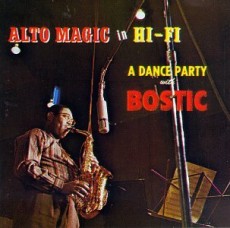
Daily Dose Of Jazz…
Earl Bostic was born in Tulsa, Oklahoma on April 25, 1912. He turned professional at the age of 18 when he joined Terence Holder’s Twelve Clouds of Joy. He then performed on the riverboats of New Orleans with Frank Marable before graduating from Xavier University.
He worked with territory bands as well as with Arnett Cobb, Hot Lips Page, Rex Stewart, Don Byas, Charlie Christian, Thelonious Monk, Edgar Hayes, Cab Calloway and others His first recording session was with Lionel Hampton in 1939 along with Charlie Christian, Clyde Hart and Big Sid Catlett. In 1938, and again in 1944, Earl led the house band at Smalls Paradise and while there he doubled on guitar and trumpet. During the early 1940s, he was a well-respected regular at the famous jam sessions held at Minton’s Playhouse.
Forming his own band in 1945, Bostic made his first recordings as a leader on the Majestic label. In the late Forties turned to rhythm and blues and had his biggest hits with Temptation, Sleep, You Go To My Head, Cherokee and his signature hit Flamingo. At various times his band included Keter Betts, Jaki Byard, Benny Carter, John Coltrane, Teddy Edwards, Benny Golson, Blue Mitchell, Tony Scott, Cliff Smalls, Sir Charles Thompson, Stanley Turrentine, Tommy Turrentine and others who rose to prominence in jazz.
He would go on to record Jazz As I Feel It with Shelly Manne, Joe Pass and Richard “Groove” Holmes. He wrote arrangements for Paul Whiteman, Louis Prima, Lionel Hampton, Gene Krupa, Artie Shaw, Hot Lips Page, Jack Teagarden, Ina Rey Hutton and Alvino Rey. His songwriting hits include Let Me Off Uptown that was performed by Anita O’Day and Roy Eldridge, and Brooklyn Boogie, which featured Louis Prima and members of the Booklyn Dodgers.
During the early 1950s Earl lived in Addisleigh Park in St. Albans, Queens before moving to Los Angeles, California where he opened his club, the Flying Fox. Suffering a heart attack he concentrated on writing arrangements. Alto saxophonist Earl Bostic, whose recording career encompassed small group swing-based jazz, big band jazz, jump blues, organ-based combos and a string of commercial successes, passed away October 28, 1965 from a heart attack while performing with his band in Rochester, New York. He was inducted into the Oklahoma Jazz Hal of Fame in 1993.
![]()
More Posts: saxophone
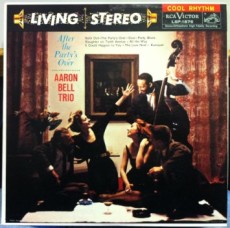
Daily Dose Of Jazz…
Aaron Bell was born Samuel Aaron Bell on April 24, 1921 in Muskogee, Oklahoma. As a child, he played piano and went on to learn brass instruments in high school. He attended Xavier University where he began playing bass, graduating in 1942 and joining the Navy until 1946.
After his discharge he became a member of Andy Kirk’s band and the next year enrolled at New York University to complete his Master’s degree. Aaron then joined Lucky Millinder’s band followed by gigging with Teddy Wilson.
During the 1950s, Bell appeared on Billie Holiday’s album Lady Sings The Blues and recorded with Lester Young, Stan Kenton, Johnny Hodges, Cab Calloway, Carmen McRae and Dick Hyman. Leaving Haymes in 1960 he took a chair opposite drummer Sam Woodyard in the Duke Ellington Orchestra.
He left Ellington in 1962 to spend time with Dizzy Gillespie before taking pit musician jobs on Broadway. He also recorded with Johnny Griffin, Sonny Stitt and Randy Weson as well as recording as a leader. Bell and Ellington collaborated once more in 1967, on a tribute to Billy Strayhorn. He held a residence at the La MaMa Experimental Theatre Club in New York City from 1969 to 1972.
Aaron was also an educator and began teaching at Essex College in Newark, New Jersey in 1970, remaining there until 1990. During this period he also toured with Norris Tumey, Harold Ashby and Cat Anderson. In the 1980s he returned to piano playing, and retired from active performance in 1989. Double bassist Aaron Bell passed away on July 28, 2003.
![]()
;
More Posts: bass
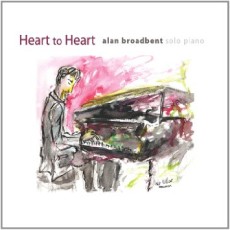
Daily Dose Of Jazz…
Alan Leonard Broadbent was born on April 23, 1947 in Auckland, New Zealand. He studied piano and music theory in his own country, but in 1966 came to the United States to study at Berklee College of Music.
Broadbent’s first professional gig was in a jazz trio with bassist Kevin Haines and drummer Tony Hopkins at Club 81 in Auckland in the mid-1960s. His first two albums as a leader in 1985, Song of Home and Further Down the Road, were recorded on the Tartar label with bassist Andy Brown and Frank Gibson, Jr. on drums. These two albums showcased his signature of reinterpretation of standards.
His first U.S. release in 1986, Everything I Love, recorded more standards on the Discovery label replaces Brown with bassist Putter Smith replaces Brown on bass; Frank Gibson, Jr. continues with the trio. By the early Nineties Alan was asked to be a part of Natalie Cole’s Unforgettable album, and toured as her pianist and conductor. At this time he wrote an orchestral arrangement for her second video with her father, When I Fall in Love, winning him his first Grammy for Best Orchestral Arrangement Accompanying a Vocal.
During the 1990s Broadbent he joined Charlie Haden’s Quartet West and it was during this period he won his second Grammy, an orchestral accompaniment written for Shirley Horn of Leonard Bernstein’s Lonely Town. As a soloist and with his jazz trio, Broadbent has been nominated for Grammys twice for best instrumental performance, in the company of such artists as Herbie Hancock, Sonny Rollins and Keith Jarrett.
Alan is Diana Krall’s conductor for her occasional orchestra concerts and conducted on her Live in Paris DVD. He has arranged for Glenn Frey, wrote six string arrangements for Paul McCartney with the London Symphony, worked with Warne Marsh, Woody Herman, Chet Baker, Irene Kral, Sheila Jordan, Bud Shank and numerous others and has toured the UK, Poland and France. In 2008 he was appointed a Member of the New Zealand Order of Merit for services to jazz.
Pianist, arranger and composer Alan Broadbent has two-dozen albums out as a leader in trio, duet nd solo performance and another seventeen as a sideman to date. He continues to perform, record and tour.
![]()
More Posts: piano
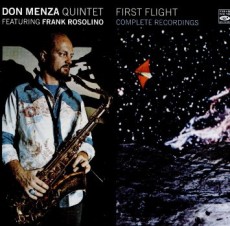
Daily Dose Of Jazz…
Don Menza was born on April 22, 1936 and raised in Buffalo, New York where he began playing tenor saxophone when he was 13. He studied with musician and teacher John Sedola.
After serving in the U. S. Army, Menza went to work in 1960 with the Maynard Jackson Orchestra for two years as both a soloist and an arranger. A short tenure with Stan Kenton and a year leading a quintet in Buffalo preceded a four-year period living in Germany (1964–68).
Later, he returned to the United States and joined Buddy Rich’s 1968 big band in the jazz tenor chair, recording the famous solo cadenza on Channel One Suite live at Caesar’s Palace in Las Vegas, Nevada. His utilization circular breathing during that performance has become known as a classic among music educators and musicians alike.
In the late 1960s, Don settled in California and performed with Elvin Jones and Louie Bellson. He also recorded with Keely Smith, Natalie Cole, Nancy Sinatra, Cold Blood, Pat Boone and Leonard Cohen.
Menza’s compositions, specifically Groovin’ Hard and Time Check have become standard repertoire in jazz studies programs at colleges and universities worldwide. He continues to be a prolific sideman and has recorded as a leader In addition to numerous recordings as a sideman Menza has recorded as a leader for Saba, Discwasher, Realtime, Palo Alto and Verve, working with John Klemmer, Carmen McRae, Lalo Schifrin, Bobby Shew, Lanny Morgan, Les Demerle, Frank Strazzeri, Don Rader, SWR Big Band and his own big band.
In 2005 Don Menza was inducted into the Buffalo Music Hall of Fame. He continues to perform, record and tour.
![]()
More Posts: saxophone
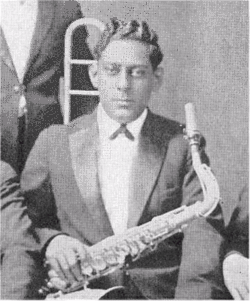
Daily Dose Of Jazz…
Lorenzo Tio Jr. was born on April 21, 1893 in New Orleans, Louisiana and raised in Bay St. Louis, Mississippi. Following in the footsteps of his father Lorenzo Sr. and his uncle Louis “Papa”, he also became a master clarinetist. Their method of playing the instrument, which involved the Albert system, a double-lip embouchure and soft reeds, was seminal in the development of the jazz solo.
Tio Jr.was instrumental in bringing classical music theory to the ragtime, blues and jazz musicians of New Orleans and he eventually played jazz himself. His main instrument was clarinet also played the oboe and joined Manuel Perez’s band in Chicago, Illinois in 1916 and Armand J. Piron’s from 1918 to 1928, recording with Piron, Bechet, Jelly Roll Morton and Clarence Williams.
As an educator among the reed players to impact early jazz who studied under Lorenzo’s direction were Sidney Bechet, Barney Bigard, Johnny Dodds, Omer Simeon, Louis Cottrell Jr., Jimmie Noone and Albert Nicholas. He taught Bigard what would become the main theme to the famous Ellington tune Mood Indigo.
Tio gigged in legendary New Orleans large ensembles such as the Lyre Club Symphony Orchestra during the late 19th century. He played in smaller combos, traditional brass bands, had a standing collaboration with Papa Celestin whenever he was in the Big Easy, and performed with the Tuxedo Brass Band.
Despite his strong ties to New Orleans, he regularly played the New York jazz scene on steamboats running between the state capitol in Albany and the Big Apple. During the late ’20s and early ’30s, He had a regular stint at The Nest Club in New York City. Clarinetist and educator Lorenzo Tio Jr., who also played oboe and tenor saxophone, passed away on December 24, 1933.
![]()


